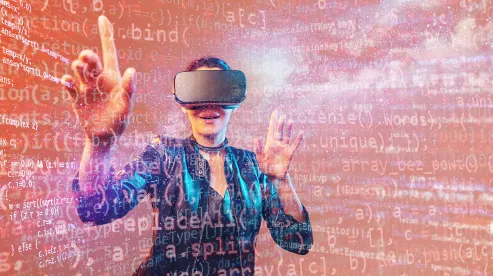Manufacturers are facing significant challenges that include the labor shortage and the skills gap and employers are not only struggling to fill vacancies, they are struggling to find workers with the necessary skills and training.
For many manufacturers, it can take years to fully train workers in some roles. The adoption of virtual and augmented reality technologies promises to help train employees faster and open new positions to the possibility of remote work. However, any widespread adoption of such technologies will present its own challenges.
Virtual and Augmented Reality
Virtual reality (VR) and augmented reality (AR) technologies are similar. Both technologies involve a user wearing a head-mounted display that resembles goggles or a helmet that tracks the user’s head motion.
VR uses solid displays, so the user only sees their virtual environment (think of the popular Oculus video game headsets). AR, on the other hand, uses a transparent display technology, so the user can still see their physical surroundings. The AR headset can enhance or modify real-world environments by overlaying them with digital imagery (imagine HUD overlays used in aircraft or cellphone cameras used to play Pokémon Go).
AR and VR Could Revolutionize Training
According to an industry survey conducted by PwC, virtual and augmented reality technologies can be used to train workers up to four times more quickly than conventional training methods.
AR and VR would allow trainees to work in virtual environments without the risk of damaging real equipment. They also would provide an experiential component not previously afforded by traditional classroom instruction. Additionally, manufacturers would be able to tailor trainings to accommodate different learning styles.
VR Can be Used to Attract New Workers
For manufacturers seeking to attract a new generation of workers, changing perceptions about the manufacturing industry remains a priority. Now that VR technology is readily available to consumers, it can be used to showcase the often brightly lit, pleasant environments afforded by modern manufacturing operations. For example, the National Association of Manufacturers developed the “Creators Wanted” campaign to change misconceptions, featuring 3D tours in virtual reality of several manufacturing facilities.
AR and VR also have the potential of allowing many repair and maintenance positions to be performed remotely. This could greatly expand a company’s access to skilled workers.
Securing AR and VR Tech
For all the potential merits of using AR and VR in manufacturing, implementing new technologies can raise cybersecurity concerns, especially when combined with the possibility of remote work. While AR and VR present low risk when used for training alone, manufacturers should consider implementing strong cybersecurity standards if using AR and VR to remotely access critical machinery. These outside connections can potentially be used by those with malicious intent to gain access to sensitive internal networks.
***
AR and VR promise to dramatically reduce training times and attract new workers. As with any technology, ongoing support and implementation costs and implementing adequate cybersecurity may be challenges. As AR and VR become more mainstream, the barriers to entry may fall.



 />i
/>i
